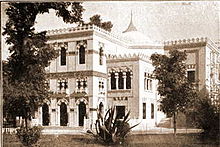Azbakeya
This article needs additional citations for verification. (February 2024) |

Azbakeya (
Administrative divisions and population

In 2017, Azbakiya diatrict/qism had 19,763 residents in its eight
| Nom | Code 2017 | Population totale |
|---|---|---|
| `Urâbî | 012007 | 2027 |
| Fajjâla, al- | 012004 | 2833 |
| Jayyâra, al- | 012001 | 837 |
| Klût Bây (Clot bey) | 012008 | 1522 |
| Qabîla, al- | 012005 | 4039 |
| Qulalî, al- | 012006 | 3439 |
| Rîḥânî, al- | 012002 | 953 |
| Zahhâr, al- | 012003 | 4113 |
History

The district of Azbakeya was built upon a place of an old
By the time of
Under the Burji Mamluks, northern cemetery became the new area targeted for the any new city expansion, since no ideological oppositions were found preventing the construction of dwelling within cemeteries. The lack of opposition allowed for the construction of striking religious buildings of monumental scale in the northern cemetery. Examples include the
During the latter half of the 15th century, two final major transformations took place in Cairo: the port of
The Azbakeya district was developed when Amir Azbak al-Yusufi, one of Qaytbay’s princes, established stables and a residence of his own and excavated Birkat al-Azbakeya, which was fed from the Cairo Citadel Aqueduct. With the Arab's Gulf always serving as the western boundary of the city and feeding nearby ponds, flooding would occur during the summer. After each flooding, surrounding lands would be transformed into lush green areas with vegetation. These beauty of the land in these areas were exquisite and the upper class fought over the each other for the first pick of the land to buy for the construction of their new palaces overlooking such bodies of water as Birkat al Fīl "Elephant Pond" and Azbakeya Pond.
Modern history

The Egyptian Museum was established by the Egyptian government in 1835 near the Azbakeya Gardens.[12] The museum soon moved to Boulaq in 1858 because the original building was too small to hold all of the artifacts.
In the 1850s, the area was renovated during the rule of

By the late 19th century, the area became a center of entertainment, with the openings of cafes, bars, gambling halls, hashish dens and at least thirteen large entertainment venues.[15] The Azbakeya gardens theater was the stage to most of the monthly concerts held by the famous Arab singer, Umm Kulthum. The Azbakeya gardens is only partially present now as two multi-story car parks have been built on large areas of the gardens.
References
- ^ Guide to Palestine and Egypt. London: MacMillon and Co., Limited. 1901. pp. 162-166.
- ISBN 9785877802247.
- ^ "Crisis en Egipto: Más de 70 muertos en nuevo día de enfrentamientos" [Crisis in Egypt: More than 70 dead in a new day of fighting]. La Segunda (in Spanish). Empresa El Mercurio SAP. August 16, 2013. Retrieved September 11, 2019.
- ^ "Western Area". www.cairo.gov.eg. Retrieved 2023-02-23.
- ^ "Khedivial Cairo". egymonuments.gov.eg. Retrieved 2023-03-26.
- ^ Khedival Cairo protection boundaries (PDF) (in Arabic). Cairo: National Organistation for Urban Harmony. 2022.
- ^ "shababchristian". Archived from the original on 2007-09-28. Retrieved 2008-02-24.
- ^ Central Agency for Public Mobilisation and Statistics (CAPMAS) (2017). "2017 Census for Population and Housing Conditions". CEDEJ-CAPMAS. Retrieved 2023-02-21.
- ^ The interactive census site is the only available source with data at the shiakha level and must be queried as follows: Statistics and analysis > Population > 2017 Data > Gender >Statistical Tables >Total population and population by sex by shiyâkha/qarya > Choose location.
- ISBN 978-977-416-777-5.
- ^ Amelineau, Emile (1980). La Géographie de l'Egypte À l'Époque Copte. Paris. p. 491.
{{cite book}}: CS1 maint: location missing publisher (link) - ^ Johnson-Roehr, S. N. (11 August 2023). "Making Egypt's Museums". JSTOR Daily.
- ^ 10 best Archived December 29, 2007, at the Wayback Machine
- ^ "Street Smart: Souq El Azbakeya, a haven for book lovers". Ahram Online.
- ISBN 978-0-86356-338-6.


